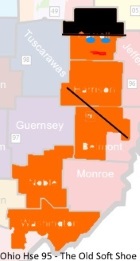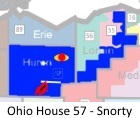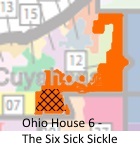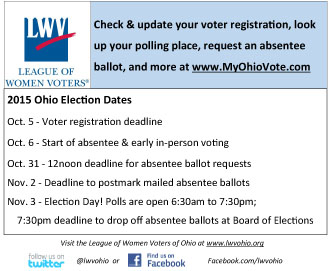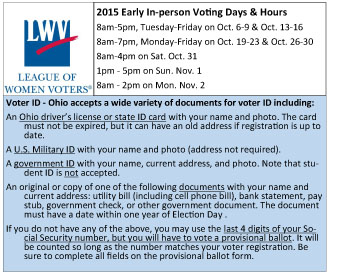Among the ballot measures for the current election in Ohio is Issue 1, which would block statehouse gerrymanders. It is the third Ohio anti-gerrymandering ballot measure in eleven years. The anti-gerrymandering measure of 2005 reached the ballot by initiative petition as one of a slate of four to address problems that arose in the troubled 2004 national election in Ohio. It would have torn up the Republicans’ map and given redistricting authority to an independent commission. The anti-gerrymandering measure of 2012 also reached the ballot by initiative petition. It was meant to address the exquisite Republican gerrymandering of 2011. It also would have torn up the Republicans’ map, and would have given redistricting authority to a citizens’ committee that could have no politicians, lobbyists, or big political donors in its membership. Both measures were backed by the Democratic Party and fought against by the Republican Party, both had significant advertising against them, and both failed by wide margins. However, the current anti-gerrymandering measure, Issue 1, reached the ballot, not by initiative petition, but by legislative action with a 28-to-1 majority in the Senate and an 88-to-8 majority in the House. It is supported by both the Ohio Democratic Party and the Ohio Republican Party, and has virtually no advertising against it.
Compared to its forerunners, Issue 1 has some weaknesses, and also a strength:
- The main weakness of Issue 1 is that it does not apply to U.S. Congressional districts, but only to the Ohio General Assembly. So, it would block critters like the Statehouse gerrymanders pictured above, but would allow monsters like the Congressional gerrymanders pictured here:

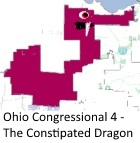
- Also, Issue 1 would not redraw a map until 2021, after the next census, so the current gerrymanders would remain till then.
- Another weakness is that it keeps politicians drawing the map, but it does require a bi-partisan majority — at least two votes from committee members of each of the two largest parties — to pass a ten-year map.
- Another weakness is this loophole: If an agreement cannot be reached, a simple majority — without the bipartisan requirement — can pass a map for four years. But Issue 1 specifically bans favoring a party as a primary criterion for mapping, and specifies three public committee meetings, which might shine a light on any attempt to do so.
- A strength of Issue 1 is that it spells-out the mapping procedure step-by-step, so that it could fairly easily be rendered to a computer program. The procedure respects county, township and municipal boundaries, and works within a reasonably equal (within 5% of perfect) apportionment range.
Though a slow, half-way measure, Issue 1 is still progress. And once Issue 1 is passed, a follow-on issue could by placed by initiative petition, and stated quite simply, like:
Extend the authority of Ohio Redistricting Commission to drawing districts for the United States House of Representatives, under the same rules and procedures as for drawing districts for the Ohio House of Representatives.
Ohio 2015 Election Info
Image Credit
All gerrymander images (CC BY) TheParagraph.com. Ohio House Source map from the office of the Ohio Secretary of State.
Sources
Issue 1 “Ohio Bipartisan Redistricting Commission Amendment, Issue 1 (2015)” – Ballotpedia
anti-gerrymandering measure of 2005 “Ohio Ballot Issues Address ’04 Election Ills”
by Quinn Hungeski, The Paragraph; November 6, 2005
anti-gerrymandering measure of 2012 “Ohio Fights Grotesque Gerrymanders”
by Quinn Hungeski, The Paragraph; August 6, 2012
both failed “Ohio Redistricting Commission, Amendment 4 (2005)” – Ballotpedia
wide margins “Ohio Redistricting Amendment, Issue 2 (2012)” – Ballotpedia
Congressional gerrymanders pictured “Ohio Fights Grotesque Gerrymanders”
by Quinn Hungeski, The Paragraph; August 6, 2012
bans favoring a party “(130th General Assembly) (Amended Substitute House Joint Resolution Number 12)” – Ohio Secretary of State (pdf)
Section 6. The Ohio redistricting commission shall attempt to draw a
general assembly district plan that meets all of the following standards:
(A) No general assembly district plan shall be drawn primarily to favor
or disfavor a political party.
(B) The statewide proportion of districts whose voters. based on
statewide state and federal partisan general election results during the last
ten years. favor each political party shall correspond closely to the statewide
preferences of the voters of Ohio.
(C) General assembly districts shall be compact.
Nothing in this section permits the commission to violate the district
standards described in Section 2. 3. 4. 5. or 7 of this article.
spells-out the mapping “(130th General Assembly) (Amended Substitute House Joint Resolution Number 12)” – Ohio Secretary of State (pdf)
Section 3.
…
(C) House of representatives districts shall be created and numbered in
the following order of priority. to the extent that such order is consistent
with the foregoing standards:
(1) Proceeding in succession from the largest to the smallest. each
county containing population greater than one hundred five per cent of the
ratio of representation in the house of representatives shall be divided into as
many house of representatives districts as it has whole ratios of
representation. Any fraction of the population in excess of a whole ratio
shall be a part of only one adjoining house of representatives district.
(2) Each county containing population of not less than ninety-five per
cent of the ratio of representation in the house of representatives nor more
than one hundred five per cent of the ratio shall be designated a
representative district.
(3) The remaining territory of the state shall be divided into
representative districts by combining the areas of counties. municipal
corporations, and townships. Where feasible. no county shall be split more
than once.
…
* * *
By Quinn Hungeski, TheParagraph.com, Copyright (CC BY-ND) 2015

